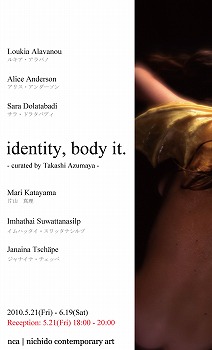 2010 5.21 - 6.19
2010 5.21 - 6.19

- curated by Takashi Azumaya -
Installation >>
*Opening Reception:
21th May 2009(Fri.)18:00 - 20:00
Artists: Loukia Alavanou, Alice Anderson, Sara Dolatabadi, Mari Katayama, Imhathai Suwattanasilp, Janaina Tschäpe
identity, body it.
―curated by Takashi Azumaya―
Place: nca | nichido contemporary art
Date: May 21st (Fri.) – June 19th (Sat.), 2010
Opening hours: Tue. – Sat. 11:00 - 19:00 / Closed on Sun., Mon. and National Holiday
Reception: May 21st (Fri.) 18:00 – 20:00
Artists: Janaina Tschäpe (Germany) / Sara Dolatabadi (Iran) / Alice Anderson (UK)
Imhathai Suwattanasilp (Thailand) / Loukia Alavanou (Greece) / Mari Katayama (Japan)
nca | nichido contemporary art is delighted to announce the sixth group exhibition, “identity, body it.”
This exhibition is curated by Mr. Takashi Azumaya, an independent curator, under the theme of “Identity” from his point of view. Six international artists are featured in the exhibition.
identity, body it.
When I was selected as a guest curator for the “Identity” series of exhibitions, my first impulse was to organize a show featuring works by female artists only. Why did I want to introduce audiences to these works in particular (which, as a matter of fact, I also personally wanted to see)? The truth is, I’m not sure what the reason is myself.
The “identity” theme in and of itself is not a particularly new one. Video, photography and other filming devices became much more affordable starting in the 1970s, which led countless numbers of artists to train their lenses on themselves and take “me” as their subject.
What often came into question, however, was who this “me” really was. Particularly amid the flurry of postmodern discourse that emerged in the late 80s, while the art world was enamored with the idea of paying heed to the “little voices” with something to say, audiences developed the habit of looking not at the work itself, peering rather at the accompanying caption that furnished information about it. This was a time when the practice of looking at the work in light of the artist’s background came to prevail.
Since the advent of the 21st century, however, the significance of this practice has been dwindling over the past few years, for a simple reason. Thanks to rapid advances in information technology – the spread of the Internet, to put it simply – the relationship between information and the identity of the person who transmits it has become uncertain. Should we believe in the validity of all this personal data about “me” that we find on Internet forums, social networking sites, video websites and cellphone novels? It’s dubious whether we are even single, unitary individuals anymore. What’s more, all those “little voices” that had no means of being heard in the last century – those of people facing persecution, or caught right in the middle of a conflict – are now easily accessible through videos uploaded onto the Internet.
In another half century or so, the dissemination of information technologies that have emerged in the past few years will lead to a turning point in history, just like how technology brought about the Industrial Revolution. After this point, forms of artistic expression that derive their meaning and significance from the act of being present at the place where the work is located (or performed), such as fine art, theater and dance, will seem to be the least dynamic. What will stand out as a result, however, is the fact that these artworks or performative acts can be attributed indisputably to their creator.
If I may make a confession: I cannot deny that the reason I have included only female artists in this exhibition is that I am a man who is interested in female attributes and properties – an interest that is something of a fetish, to put it another way. At the same time, I also have a deep respect for how these artists attempt to embody a certain “identity” while believing that their own bodies are inalienably theirs.
The works of these artists, then, represent attempts to embody a sense of identity in the context of our time. No more need for relative criteria that determine who that “me” is. The search for identity in these works proceeds from a single, indisputable location – what “me” means to “me”.
- Takashi Azumaya (Independent curator)
Takashi Azumaya
Born in Yokkaichi City, Mie Pref. Japan in 1968, Azumaya received his M .A. Painting from Tokyo University of the Arts in 1994. After working at Setagaya Art Museum, Tokyo from 1994 to 1999, he has been working as an independent curator and a contributor to many well-known art magazines. His distinctive career includes a curatorial staff at Tokyo Opera City Art Gallery in 1999 and an associate curator at Mori Art Museum from 2003 to 2004. Above all, Azumaya participated in various projects in Japan and abroad such as "Yokohama 2001: International Triennale of the Contemporary Arts," "Media City Seoul 2002(commissioner)," "Busan Biennale 2008(curator)," etc.
In current, artistic director of the Busan Biennale 2010.